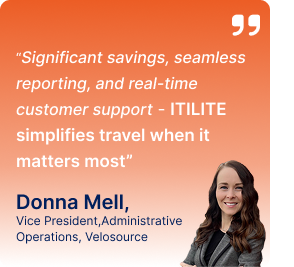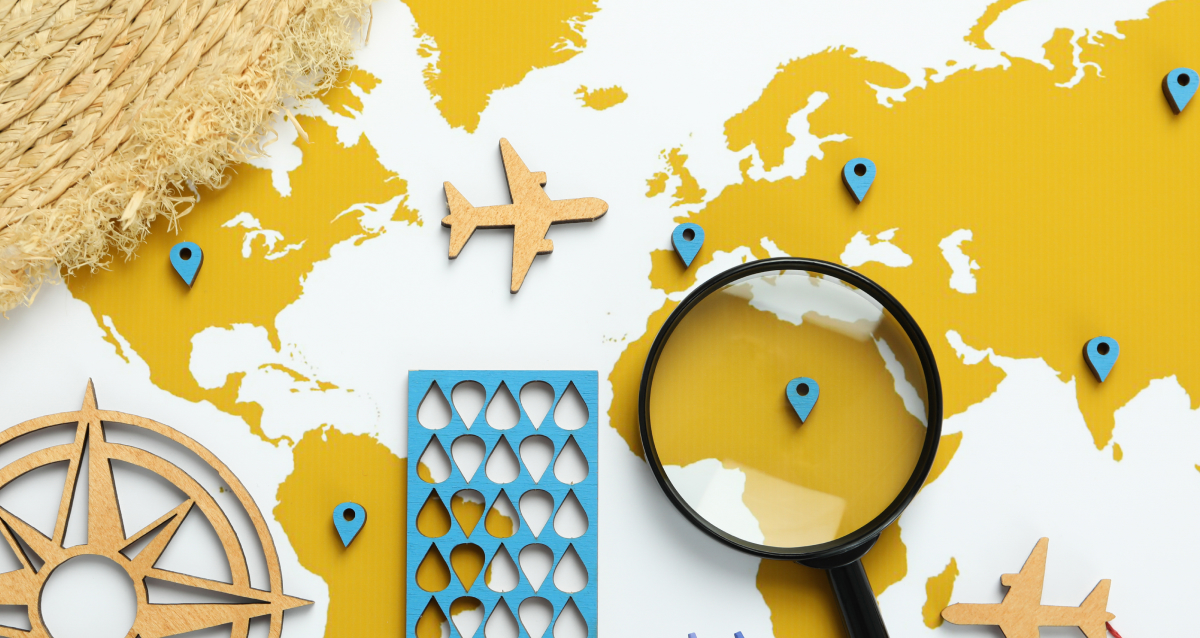
Business travel is a cornerstone of corporate operations, yet managing expenses effectively remains a daunting challenge for many organizations. According to Statista, in 2023 alone, businesses spent approximately $1.45 trillion globally on corporate travel expenses. Hence, organizations worldwide must implement expense management methods.
However, understanding and mastering these expenses are crucial for financial health and operational efficiency. Every aspect demands careful planning and oversight, from airfare and accommodation to meals and incidental costs. Whether you’re a seasoned traveler or new to managing corporate travel, navigating these intricacies can significantly impact your company’s bottom line.
Hence, in this blog, we will help you understand what exactly business travel expenses are and the different types. We will also help you know what categories can be claimed under a business travel expense and how to manage them efficiently.
What Should a Business Travel Expense List Include?
Business travel expense is the cost an employee incurs to accomplish work goals while on a business trip. According to the Internal Revenue Service (IRS), employees are considered to be on a business trip if they are traveling away from their primary place of work longer than their ordinary office hours and need to get sleep to meet the demands of their job while away.
Any expense incurred while making travel arrangements is considered a business travel expense. This can include the costs of transportation, meals, and accommodation. Organizations can track and manage such costs by creating travel expense lists using expense tracking software.
Companies often cover employee travel expenses by booking transportation and accommodation for business trips. However, employees who pay for business travel expenses are often reimbursed.
Therefore, for self-paid trips, all employees are expected to create a travel expense list and preserve the expense receipts to present as proof of reimbursement upon returning to the office.
What can be Included in a Business Travel Expense List?
An expense qualifies as a business or employee travel expense if the traveler has incurred it on a business trip for a work-related objective like a meeting or a seminar. However, some companies might also cover Bleisure travel expenses. In such cases, the employees may mix leisure with business travel, but they should be mindful of the company’s travel and expense policy.
If unsure if an expense is policy-compliant, they must review the travel expense list in the policy guidelines.
In general terms, business travel expenses can be broken into the following categories:
1. Transportation Cost
Transportation costs include all the expenses associated with using or maintaining a vehicle for business travel. Employees can claim costs they incur on flights, trains, taxis, cabs, parking fees, etc. Moreover, if they use their own vehicle for business travel, they can claim reimbursement as per the US Mileage Reimbursement Policy.
2. Accommodation Expenses
Accommodation expenses are the costs employees incur while making accommodation arrangements for a business trip. Employees can claim the money they spend on business travel accommodations such as hotels and resorts.
3. Subsistence Expenditure
Subsistence expenditure is the money employees spend on sustaining themselves while traveling for work. It is also known as per diem or meal allowance. Under this category, employees can claim the expenses they incur on food and drinks they consume during a business trip.
4. Incidental Expenses
Incidental expenses are minor ancillary fees incurred on top of the main service or item paid for during any business activity. For instance, an employee who takes a cab from the airport to their hotel will pay the fare and tip the driver if it is customary according to the destination’s etiquette. In this case, the cab fare is the main expense, and the tip is the incidental expense.
What can’t be Included in a Business Travel Expense List?
While companies cover most expenses to improve employees’ travel experience during a business trip, there are certain amenities for which employees have to pay from their pockets. Any expense under the following three categories cannot be claimed as a business travel expense:
1. Personal Expenses
Personal expenses contain all the non-business purchases made by the employees. For instance, buying a gift or souvenir for colleagues will be classified under personal expenses. Employees cannot claim any personal expenses or fines for reimbursement by the company. They need to bear all such expenses from their own pockets.
2. Companion Expenses
Companion expenses are all the costs incurred if the business travelers have a friend or a family member accompanying them during business travel. Employees cannot claim the amount they spend to make stay and travel arrangements for their companions.
3. Commuting Expenses
Commuting expenses are the costs employees incur while going back and forth to their workplace. Such expenses include the cost of using a personal vehicle(cars and bikes) and public transportation to travel to work.
According to the IRS guidelines, employees cannot claim regular commuting expenses because they don’t qualify as a business travel expense.
Different Methods of Reimbursing Business Travel Costs
There can be multiple ways to pay business travel costs to your employees. But first, it is important to ensure that your travel & expenses policies clearly state the mode of payment used for different travel requirements so that there is no confusion later.
Mentioned below are some of the ways in which employees can pay for business travel expenses:
1. Per Diem
Per diem (or per day) means a daily allowance that companies give to employees. The per diem policy defines how much employees can spend per day on food and lodging, while they travel for work.
You can either give it in advance or the employees can get it reimbursed after returning from the trip. You can read up further about per diems in the US and how to set them as per the IRS guidelines.
2. Corporate Credit Card
A corporate credit card is a credit card issued by a company to employees for business-related expenses. It allows employees to pay for expenses without using their personal cards or cash.
Using a corporate credit card can help you control travel costs by setting clear spending limits for your employees. Moreover, you can reconcile all the credit card transactions easily and conduct seamless travel and expense audits.
3. Cash Payments
While traveling internationally, employees might incur some miscellaneous expenses like stationary shopping from a local store that doesn’t support card or other online payment methods. Therefore, they need to carry cash for such situations.
You can provide an estimated amount of cash (or a little more than that) for the whole trip to the employees and ask them to submit receipts for all the expenses for expenditure management. They can return the excess amount after they return from the trip.
4. Post-trip Reimbursement
Sometimes, it is challenging for employees and employers to estimate the entire cost of a business trip in advance. The estimation is challenging because they can’t predict miscellaneous expenses like washing, repairs, and tolls in advance accurately.
Therefore, you can reimburse the expenses incurred by employees during the trip after they return to the office. For all such post-trip reimbursements, the employees can file all the expenses manually on a spreadsheet expense management software and submit the receipts to the finance department for verification and approval after they return to the office
Alternatively, they can use a more efficient method of automatic filing with travel expense software like itilite. The itilite platform uses OCR technology to scan and fetch information directly from the expense receipt, making expense filing faster and error-free. Moreover, your employees can create expense reports and send them for approval from anywhere around the globe, with their mobile device. This can help make the reimbursement process faster and easier.
To get a first-hand seamless expense management experience, you can get a free demo of itilite expense management software now.
How to Track and Calculate Business Travel Costs or Expenses
1. Record and Tag Each Expense
Recording and tagging every expense incurred during a business trip is vital because employee travel expenses are tax-deductible in many countries, meaning companies can save a lot of money. Therefore, you must keep a comprehensive record of all the business travel costs your employees incur.
You should tally your expense register at least twice a week to ensure every transaction, including cash payments, is recorded. Moreover, it is a good idea to keep your expense records granular. Detailed records can help you fetch meta information whenever required. You can tag and group the expense as follows:
- According to trip type
- According to the department
- According to the expense
2. Calculate Entire Trip Expenses
Calculating the cost of the whole trip is essential for making future business travel budget predictions. Therefore, you must analyze the cost of the entire trip instead of immediately splitting travel, meal, and accommodation expenses into their dedicated spreadsheets. You must ensure every element of the trip is accounted for before reviewing the trip expenses.
3. Categorize the Expenses
After calculating the cost of the entire trip, you should classify the expenses into multiple categories for better understanding. For example, you can classify the amount spent on flights under travel, hotel stays under accommodation expenses, and small, non-recurrent expenses like laundry under miscellaneous expenses.
Categorizing expenses can help you identify where you are over or underspending and comes in handy while filing taxes.
4. Project the Travel Spends
Once you have recorded, tagged, and categorized your expenses, you can look at them to calculate and predict how much your employees are likely to spend on their next trip. Moreover, with insights on category-wise spending, you can reduce the expense limits where you detect overspending.
How to Manage Business Travel Expenses
Managing corporate travel expenses is essential for cost-saving. Here are some ways you can manage business travel expenses:
1. Automate Business Travel Expenses with a T&E Solution
One of the best ways to manage travel expenses is to use a travel and expense management platform that completely automates your approval and reimbursement workflows.
Automating your reimbursement process makes expense filing easy for employees and eliminates any manual filing errors. Moreover, they will be able to scan and upload all the invoices on the go, leading to accurate expense filing.
Additionally, with real-time alerts, your travel managers will know if there are any out-of-policy bookings and can control them.
By keeping track of travel expenses through a travel and expense management software like itilite, companies can save money and avoid penalties. To estimate your potential savings on travel expenses, try using our savings calculator.
2. Fix the Payment Method
You need to set a fixed payment method for various business travel expenses list. For instance, you can set per diem for food and accommodation expenses, and mileage rates for transportation. However, you must be consistent with the payment methods you choose for each type of business travel expense.
3. Set Proper Travel Expense Procedure
You need to set guidelines for estimation, submission, and reimbursement of expenses. Keep in mind these points while framing your policies:
- Estimating the expenses: Ask employees to make an end-to-end projection of expenses before the trip. It will give them an estimate of how much they will spend during their trip.
- Receipt Collection: Guide your employees to collect every receipt in a standard format as per the company’s travel expense policy requirement. For instance, you can ask employees to preserve tax invoice in PDF/ computer-generated receipt, or physical receipt format.
- Timely expense submission and claims: Set a strict deadline for your employees to file the expenses after they return from their business trip. For instance, you can ask them to file the expenses within a month of their return. Any expenses filed post that will not be considered.
- Expense reimbursement period: Create fixed timeline to reimburse your employees to avoid frustration and demotivation.
4. Encourage Employees to Follow the Corporate Travel Policies
As a corporate travel manager, you must inform the employees about the company’s travel expense policies and ensure compliance. The following steps can help you create awareness about your policies and increase adoption:
- Make the travel policy easily accessible: You have to make sure that the travel and expense policies are placed at a common place where any employee can find them such as the intranet or any other common folder.
- Send company-wide emails regularly: You should keep sharing the updates in company travel expense policy via regular emails.
- Organize Training Sessions: You can organize regular employee training sessions to create awareness about the travel expense policy guidelines and their importance. The sessions can comprise of fun activities like play quizzes to keep the employees engaged while educating them about the travel expense policy.
- Invest in an integrated T&E software that allows granular policy configuration: You can also invest in an integrated travel and expense management software that allows multi-level policy configuration. Such software can set a travel and expense policy according to multiple departments, employee levels, trip durations, etc. Moreover, the software will present the terms of the travel policy to employees at the time of booking so that your employees are aware of their expense limits and get a notification if they book out of policy.
Do’s & Don’ts to Reduce Corporate Travel Expenses
As a travel manager, it is your responsibility to reduce travel costs. However, you have to take into account other factors, such as employee satisfaction and travel safety solutions.
For instance, while selecting hotels and accommodations, it is essential to consider the sanitation, hygiene, and security of the location, even if you need to spend a bit more.
Here are some do’s and don’ts to follow as you think of controlling business travel expenses:
| Do’s | Don’ts |
| Give rewards and incentives to cost-saving employees | Allow last-minute bookings except in case of emergencies |
| Include travel expense policy compliance exceptions | Give a shared hotel room to employees. It can be unpleasant and uncomfortable. |
| Encourage the use of public transportation or shared transportation (in case of group travel) | Focus only on corporate deals and not on the well-being of travelers |
Optimize your Business Travel Expense Management
Managing travel expenses is one of the significant tasks to save costs for your company. This complete guide to business travel expenses has explained all steps necessary for better expense management.
However, to implement these measures in your organization, you will require an advanced corporate travel management platform like itilite.
The itilite travel and expense software can help you save costs, ensure near 100% travel and expense policy adoption, and make the process of filing expenses easier and faster. We offer a free demo of itilite to see how it helps in reducing business travel expenses.
Frequently Asked Questions(FAQs)
To organize your travel expenses, you need to categorize them into transportation, accommodation, meals, entertainment, etc. Use expense management software to scan receipts, and it will automatically categorize expenses accordingly.
To calculate business travel expenses, include transportation costs (flights, car rentals, etc.), accommodation, and meals (using actual costs or per diem rates). Also, account for miscellaneous expenses such as business calls and parking fees. Keep detailed records and use expense management software for accurate tracking.
Yes, some business travel expenses are taxable, while others are non-taxable. Non-taxable expenses generally include transportation, accommodation, and meals directly related to business activities. However, personal expenses or any costs that do not have a clear business purpose are taxable. It’s essential to keep detailed records and receipts to differentiate between these categories for accurate tax reporting.
This depends on the company’s spending policy.
a) Some companies allow it, and they ask employees to file for reimbursements.
For this use case, we have a “manage cards” feature in expense. Users can add a specific bank’s card (we support more than 8000+ banks). Every swipe is automatically visible in the expense product. Users can create expenses with a click of a button and apply for reimbursements.
b) Some companies provide every employee with corporate cards. These corporate cards are paid by the company, and hence, users only need to add receipts to every transaction. With itilite, companies can issue Virtual and Physical corporate cards to their employees with spend controls and different card limits.












